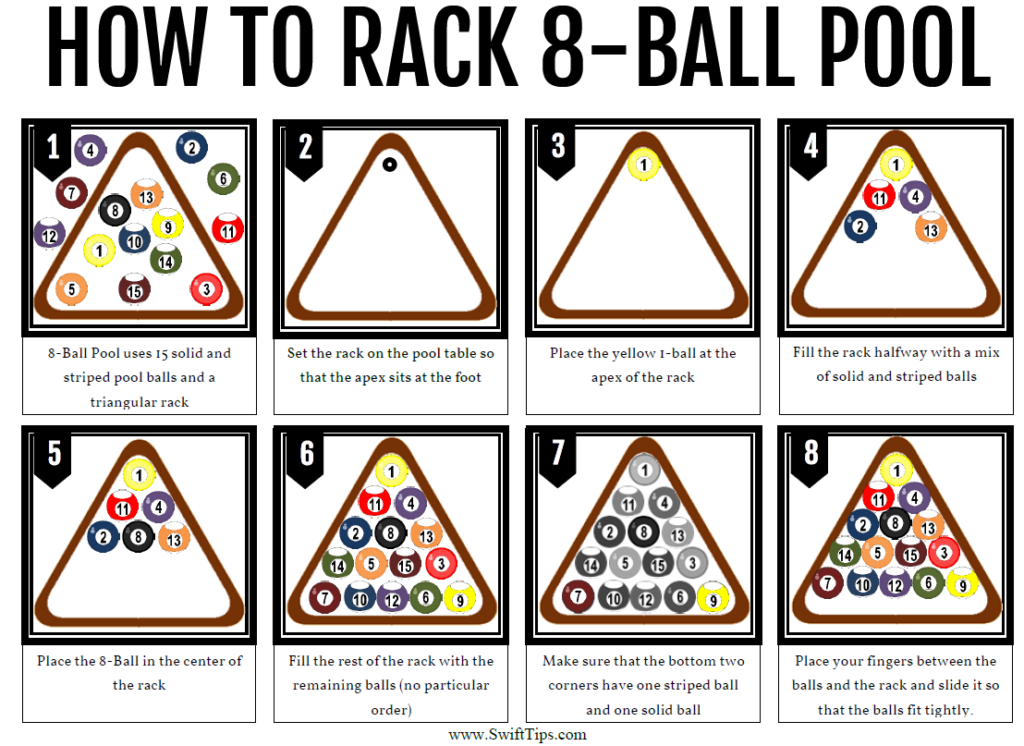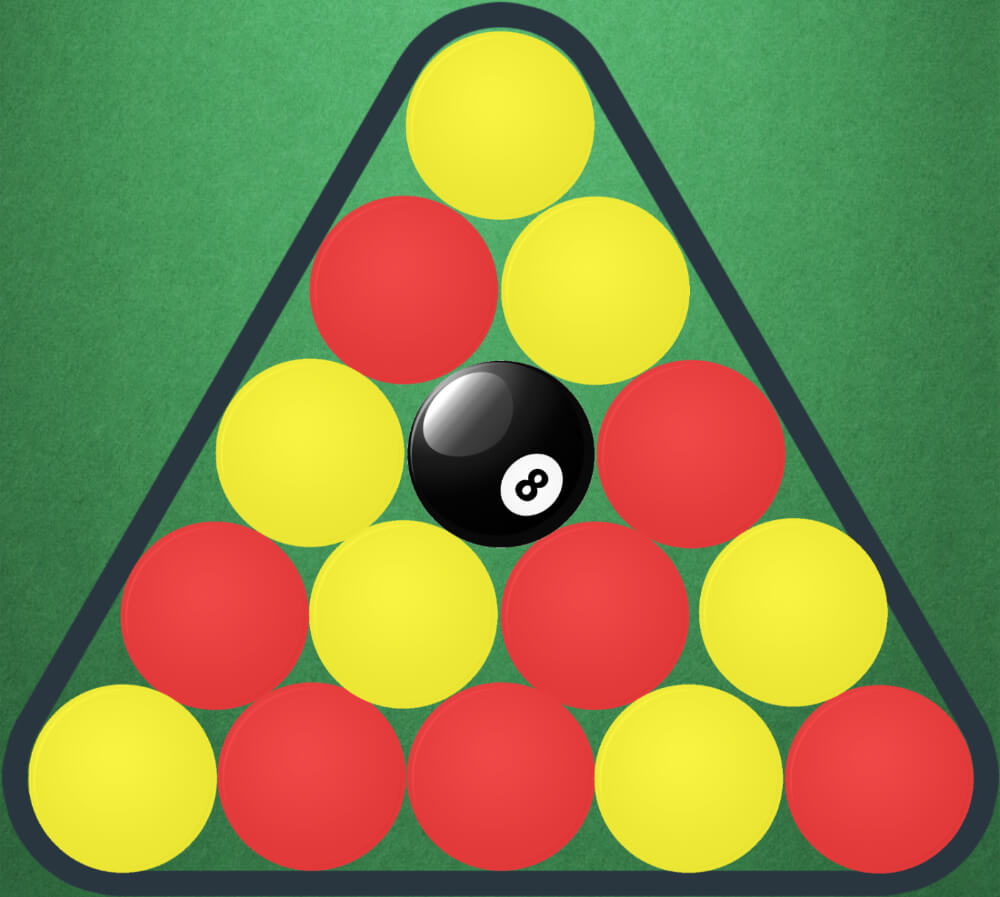Pool Racking: Your Guide To The Perfect Break & Beyond!
Ever wondered what separates a casual pool player from a seasoned pro? The answer, in part, lies in the often-overlooked art of the perfect rack a fundamental skill that dictates the flow and fairness of every game.
Racking, the initial setup of the billiard balls, might seem like a simple task, but mastering it is crucial for a satisfying and competitive pool experience. Its the foundation upon which every game is built, influencing the break shot, the subsequent ball-running opportunities, and ultimately, the outcome of the match. While the mechanics of racking are relatively straightforward, the nuances, variations, and specific requirements for different pool games add a layer of complexity that separates the novice from the expert.
Understanding the intricacies of pool racking opens up a new dimension to your game, allowing you to appreciate the subtle strategies and techniques employed by professional players. Its not just about placing the balls in a triangle; its about ensuring a tight, legal, and consistent rack that promotes fair play and maximizes your chances of a successful break.
Before diving into the specifics, let's understand what it takes to be a pool player, or a professional at racking pool balls.
| Personal Information: | |
| Full Name: | [Insert Name Here - e.g., John Doe, or a fictional name] |
| Nickname (if any): | [Insert Nickname Here - e.g., "The Rack Master"] |
| Date of Birth: | [Insert Date of Birth Here] |
| Place of Birth: | [Insert Place of Birth Here] |
| Nationality: | [Insert Nationality Here] |
| Career Information: | |
| Occupation: | Professional Pool Player/Pool Instructor/Pool Enthusiast |
| Years of Experience: | [Insert Years of Experience Here] |
| Significant Achievements: | [List any notable achievements, e.g., Tournament wins, high run records] |
| Professional Information: | |
| Specialization: | Racking Techniques, Pool Game Strategies |
| Notable Skills: | Precise ball placement, Understanding of various game rules, ability to teach |
| Style of Play: | [e.g., Aggressive, Tactical, Defensive] |
| Endorsements (if any): | [List any endorsements, e.g., Cue manufacturers, apparel brands] |
| Reference: | Example: World Pool-Billiard Association (WPA) |
The anatomy of a pool table is integral to understanding the racking process. The key components are the felt-covered playing surface, the cushions (rubber edges around the table), the pockets (where balls are sunk), the foot spot (a specific marking on the table), and the foot string (an imaginary line running across the table). The foot spot is where the apex, or the foremost ball, of the racked triangle rests.
Different pool games have distinct racking rules. The type of rack and the number of balls may also vary. For instance, 8-ball and 9-ball have specific arrangements, while games like straight pool have different requirements. Its essential to know these rules to ensure a fair and consistent break.
Let's explore the basic requirements for a perfect rack, suitable for most pool games. You'll need a standard triangle rack capable of accommodating fifteen balls. Place the rack on the foot spot, carefully aligning it along the foot string. The top of the triangle, or the apex, must be positioned precisely at the foot spot. This is crucial for a consistent break, giving the cue ball a predictable point of contact.
Next, you need to arrange the balls inside the rack. In many games, the order of the balls is not prescribed, except for the placement of the head ball (the one at the apex, which sits on the foot spot) and the corner balls. Typically, you'll place a stripe ball in one bottom corner of the rack and a solid ball in the other. The 8-ball is often placed in the center of the third row (although, specific rules vary by game). All other balls, including the head ball, can be placed randomly, ensuring they are snug against each other.
To ensure a legal and tight rack, the balls must be packed together as tightly as possible, minimizing any gaps between them. Gaps can lead to a weaker break and reduce the chances of successfully potting a ball on the break. You can lightly tap the balls together while racking to ensure this tight arrangement. Once the balls are set, carefully remove the triangle rack without disturbing the arrangement.
Specific games have unique racking requirements. In 8-ball, for example, you place a stripe ball in one corner and a solid ball in the other, with the 8-ball in the center. In 9-ball, the 1-ball is placed at the apex, and the 9-ball is placed in the center of the triangle. Straight pool (continuous 14:1) has slightly different rules, it doesnt matter where and how any of the 15 object balls are placed inside the triangular rack. You can rack straight pool just like you would rack 8-ball, except in this game.
For rotation pool, follow essential steps to rack pool balls effectively. Make sure you have a standard triangle rack that holds all fifteen balls. Place the triangle rack at the foot spot, aligning it properly. The apex ball should sit on the foot spot, usually the 1-ball. Place the remaining balls randomly.
Bar rules, are often more informal than those of professional tournaments, but they still influence the setup. Make sure you have a standard triangle rack that holds all fifteen balls. Place the triangle rack at the foot spot, aligning it properly. The apex ball should sit on the foot spot, usually the 1-ball. Place the remaining balls randomly, some rules of the games use bar rules.
Here are some key steps on how to rack pool balls.
- Understand the Game: Familiarize yourself with the specific racking rules of the pool game you are playing.
- Equipment Check: Ensure you have a standard triangle rack and a complete set of billiard balls.
- Table Preparation: Make sure the pool table is clean and the felt surface is in good condition.
- Foot Spot Alignment: Place the racking triangle in position along the foot string of the table. Center the rack along the foot string with the top of the triangle at the foot spot.
- Apex Ball Placement: The apex ball should sit directly on the foot spot.
- Corner Ball Placement: Place a stripe ball in one corner and a solid ball in the other (8-ball rules).
- 8-Ball Placement (8-Ball): Position the 8-ball in the center of the third row.
- Ball Tightness: Carefully place the balls in the rack, ensuring that they are tightly packed together without any gaps or spaces.
- Random Ball Placement: Fill in the rest of the rack with the other balls randomly (except in games with specific ball number arrangements).
- Rack Removal: After ball placement, carefully remove the rack, leaving a tightly packed arrangement of balls ready for the break.
Many players place one ball in the fifth and first row, two balls in the fourth and second rows, and three balls in the third row, but it's not mandatory, you can put the rest of the balls randomly.
For straight pool, known as continuous 14:1, is slightly different from other pool games. To rack the table for a game of straight pool correctly, rack just like you would rack 8-ball, except in this game, it doesnt matter where and how any of the 15 object balls are placed inside the triangular rack.
This is the basic skill for beginners to learn and practice. To ensure the highest quality of the game, the racking must be set up correctly.
The choice of the break shot can drastically affect the course of a game. A well-placed break shot can spread the balls evenly, give you easy shots, and potentially lead to an immediate run of balls. This highlights the importance of the racking in creating a favorable opening opportunity.



Detail Author:
- Name : Charity Crooks
- Email : wgerlach@schulist.org
- Birthdate : 2005-11-05
- Address : 98382 Veum Road New Amya, GA 71156
- Phone : +12838550520
- Company : Wisozk-Zulauf
- Job : Eligibility Interviewer
- Bio : Pariatur maiores sequi ad sunt corporis excepturi autem enim. Ipsa laborum aperiam voluptatum id eum enim. Minima repudiandae dolorum assumenda quaerat est. Facere eum quas dolorum laboriosam.